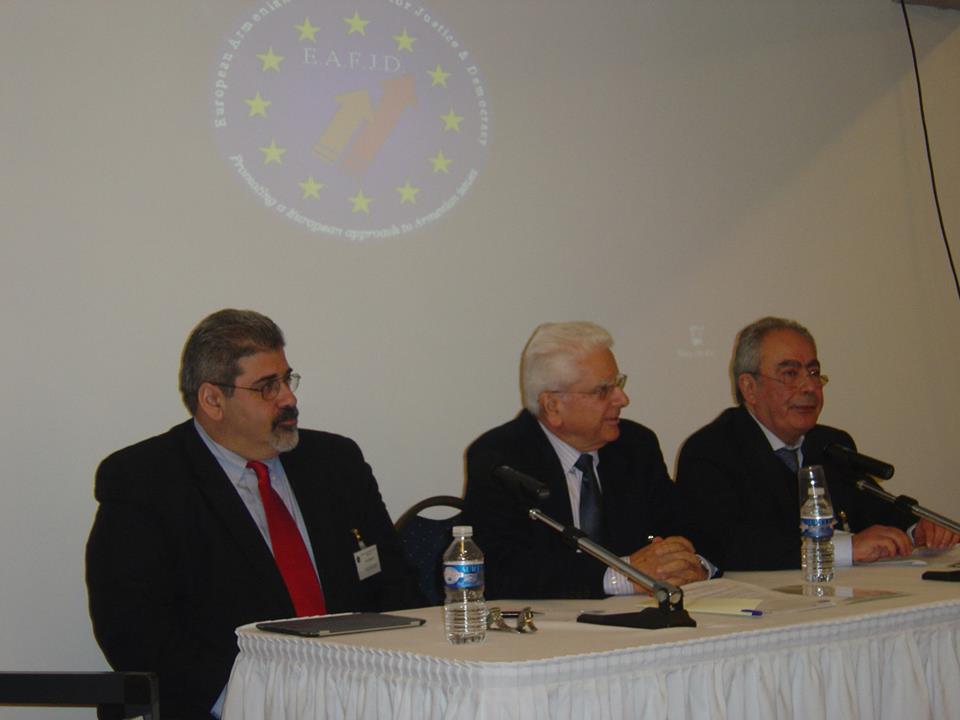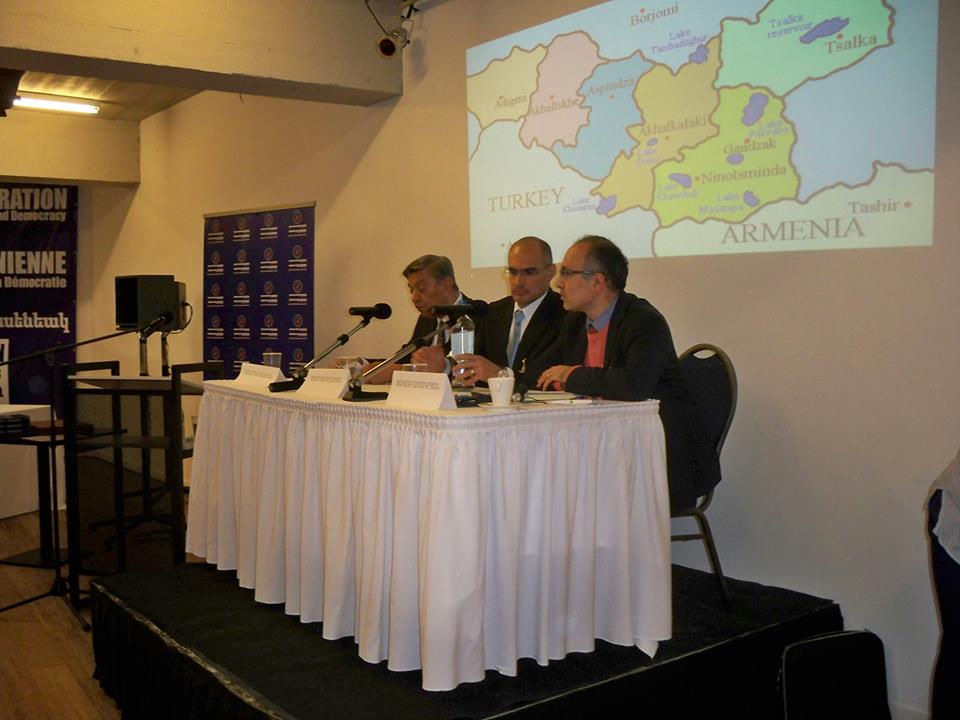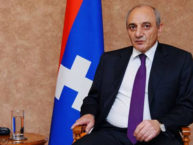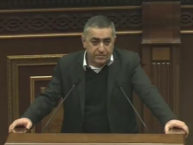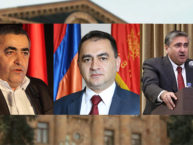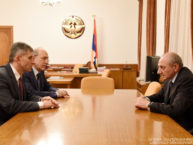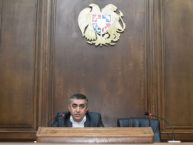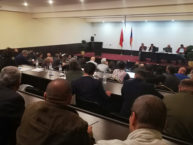Armenians from all over Europe were gathered in Brussels, Belgium for the 3rd European Armenian Convention, convened on October 14-15 and organized by the European Armenian Federation for Justice and Democracy (EAFJD).
On October 14, the Convention took place at the Armenian Cultural Center where EAFJD President, Kaspar Karampetian delivered the opening remarks.

(L-R) Mountainous Karabakh Republic Foreign Affairs Minister, Karen Mirzoyan, Head of Permanent Mission to EU, Amb. Avet Adonts, Speaker of the Armenian Parliament, Hovik Abrahamyan, Mountainous Karabakh Republic President, Bako Sahakyan, Catholicos of Cilicia, Aram I, ARF-D Bureau member, Hagop Der Khachadourian, Primate of Armenian Apostolic Church of France, Archbishop Norvan Zakarian, Mountainous Karabakh Republic Vice Prime Minister, Artur Aghabekyan
Mountainous Karabakh Republic President, Bako Sahakyan, Armenian Parliament’s Speaker, Hovik Abrahamyan, ARF-D Bureau member and Armenian National Committees coordinator, Hagop Der Khachadourian, Catholicos of All Armenians Karekin II representative and Primate of the Armenian Apostolic Church in France, Archbishop Norvan Zakarian and Catholicos of the Holy See of Cilicia, Aram I addressed the Convention.
Following the speeches, an award-presenting ceremony took place. EAFJD staff members and partners awarded Raffi Arslanian, Kapriel Chemberji, Punik Foundation, Nerses Ohanian, Souren Ohanian, Braian Fera, Andre Gumushjian and Alecco Bezikian for their vital financial contribution to the EAFJD.
The first day the topics of the agenda were discussed in three panels. The first one concerned the Centennial of the Armenian Genocide with the Director of the Institute for Diaspora and Genocide Studies of Bochum’s Ruhr University, Prof. Dr. Mihran Dabag, and the Director of the ARF-D International Secretariat,
Giro Manoyan. The panel was moderated by ANC Cyprus member, Arto Tavitian. The second discussion touched the Turkish-Azeri anti-Armenian lobbying and the Armenian response to it. The keynote speakers were the Director of
the ANC Office in France, Hratch Varjabedian and the Secretary General of the European Friends of Armenia (EuFoA), Michael Kambeck. In the third panel, the Chairman of the Executive Committee of Greece, Ara Mangoyan and Chief-editor of “Orer” magazine (Czekh) Hakob Asatryan presented the Western and the Eastern European Armenian communities. Both panels were moderated by EAFJD Communication Officer, Bedo Kurkjian-Demirjian.
The coordinator of Armenian NGOs in Samtskhe-Javakheti (Georgia), Artak Gabrielyan spoke about the problems that the Armenians of the region face. The discussion concluded that it would be appropriate to hold a special conference in the near future, dedicated to this issue.
The President of the Forum of Armenian Associations of Europe (Slovakia), Ashot Grigoryan presented the Forum’s work within the UN about Armenian monuments and Van civic organization (Russia) President, Gagik Melikyan presented his book “Armenian Genocide by Ottoman Turkey, 1915. Testimony of Survivors, collection of documents”.
At the end of the first day, EAFJD President, Kaspar Karampetian read a letter by the Emergency Relief and Recovery Body of Syrian Armenians addressed to the Convention. The letter concerned the difficulties that the Syrian Armenian community faces and called the European Armenian communities to assist financially. Karampetian gave a summary of the EAFJD work that aimed both at collecting funds and at providing safety to the Syrian Armenians.
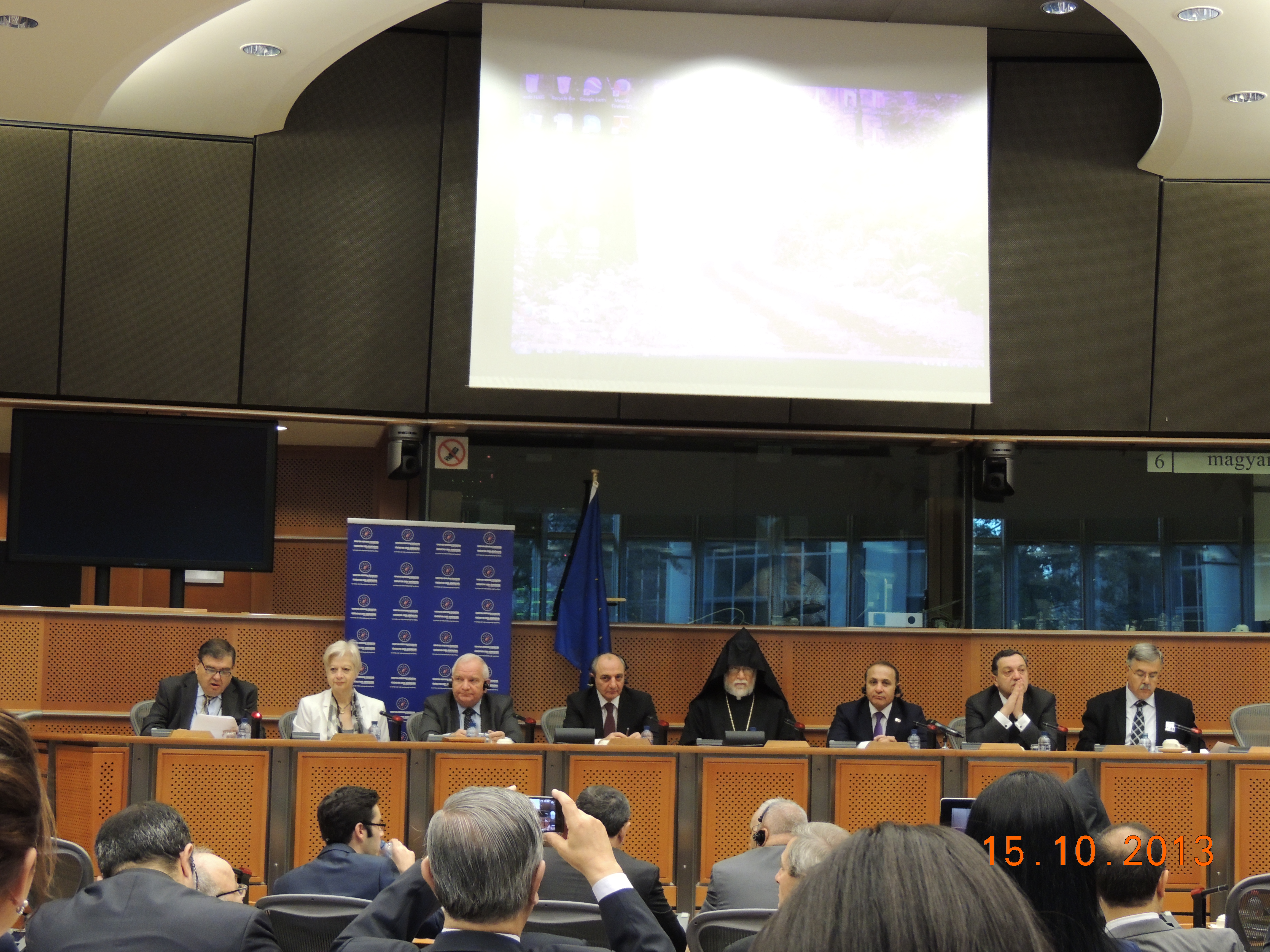
(L-R) Kaspar Karampetian, Eleni Theocharous, Joseph Daul, Bako Sahakyan, Aram I, Hovik Abrahamyan, Avet Adonts, Hagop Der Khachadourian
The second day, the sessions convened in the European Parliament. After a welcoming speech by EAFJD President, Kaspar Karampetian the floor was given consecutively to Joseph Daul, President of the European People’s Party (EPP) Group in the European Parliament which hosted the Convention, Dr. Eleni Theocharous, President of the EU-Armenia Friendship Group in the European Parliament, Bako Sahakyan, President of the Mountainous Karabakh Republic spoke for the first time from the European Parliament’s floor about his country in what is considered a historical moment, Hovik Abrahamyan, Speaker of the Armenian Parliament, Hagop Der Khachadourian, ARF-D Bureau member and Armenian National Committees’ Coordinator and to Aram I, Catholicos of the Holy See of Cilicia who elaborated on the return of the Armenian church properties from Turkey.

Day 2, panel 1: (L-R) Yair Auron, Kirsten Meersschaert Duchens,
Theofanis Malkidis, Frank Engel, Henry Theriault, Vladimir Vardanyan, Hagop Der Khatchadourian
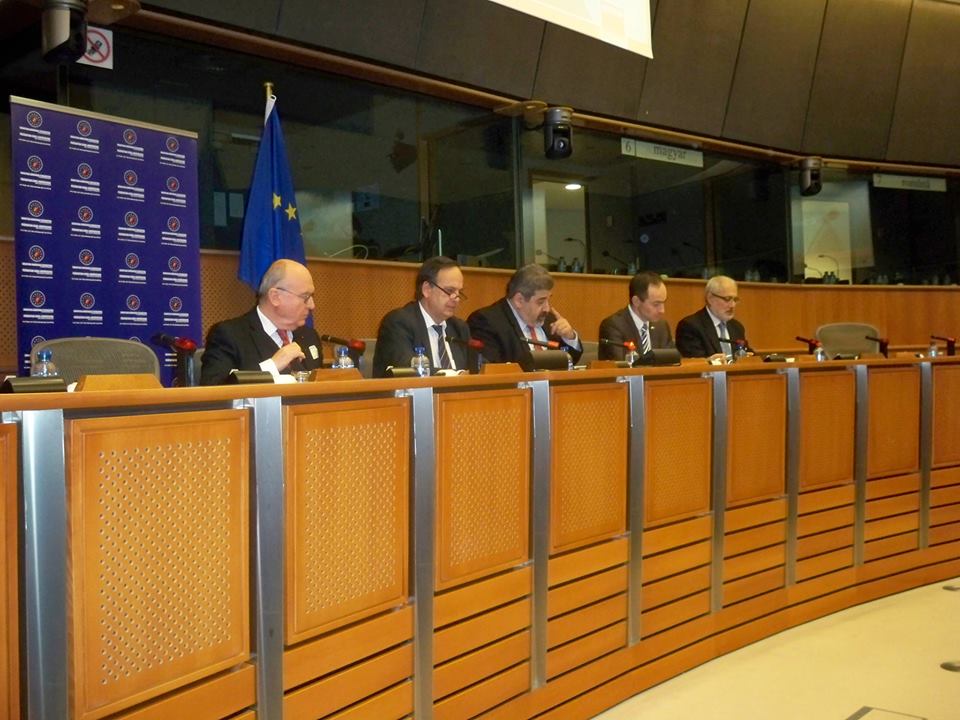
Day 2, panel 2: (L-R) Bernard Fassier, Knut Fleckenstein, Giro Manoyan, Andrey Kovatchev, Vahan Hovhannesian
The first panel touched the subject of the Armenian Genocide and International Law. Professors Yair Auron (Israel), Theofanis Malkidis (Greece), Vladimir Vardanyan (Armenia), Henry Theriault (USA) as well as legal expert Kirsten Meersschaert Duchens (Netherlands) expressed their views on the Armenian Genocide and the issue of reparations. Moderating this panel were Frank Engel (Luxembourg), MEP and Vice President of the EU-Armenia Friendship Group in the European Parliament and Hagop Der Khachadourian.
The next discussion was about the New Perspectives in the South Caucasus with guest speakers Andrey Kovatchev (MEP, Bulgaria), Vice Chair of the Committee on Foreign Affairs, Knut Fleckenstein (MEP, Germany), Vice co-Chair of the Committee on Political Affairs, Human Rights and Democracy of the Euronest PA, Dr. Ioannis Charalambidis (Cyprus), President of Ledra College, Geoffrey Robertson QC (UK), member of the United Nations internal Justice Council, Bernard Fassier (France), ex. co-Chair of the OSCE Minsk Group, Vahan Hovhannesyan, Vice Chair and Bureau member of Euronest PA). Giro Manoyan, ARF-D International Secretariat Director was the moderator of this panel.
On the same day, at the initiative of EAFJD, the President of the EU-Armenia Friendship Group in the European Parliament, Dr. Eleni Theocharous scheduled a meeting between the Mountainous Karabakh Republic delegation, headed by its President, Bako Sahakyan and comprised of Vice Prime Minister, Artur Aghabegyan, Foreign Affairs Minister, Karen Mirzoyan and Press secretary of the President, Davit Babayan, and MEPs from various political factions and member-countries.

Day 2, panel 2: (L-R) Bernard Fassier, Geoffrey Robertson, Giro Manoyan, Andrey Kovachev, Vahan Hovhannesyan, Ioannis Charalambides
During these two days MEPs, politicians and experts as well as representatives of European Armenian communities and organizations discussed about the various aspects of Armenia’s integration in Europe, the progress of the Mountainous Karabakh Republic, the problems and the capacities of the European Armenian communities, the reparations of the Armenian Genocide and the drawing of a new policy to pursue the rights of the Armenians.
EAFJD President Kaspar Karampetian stated, “We consider the 3rd European Armenian Convention to be of historical significance in the sense that for the first time religious and civic-political representatives from Armenia, Artsakh (Mountainous Karabakh) and the Diaspora gathered in Brussels and particularly in the European Parliament to unanimously voice their determination to work for the benefit of the development of Armenia, the recognition of Artsakh and the survival of the Diaspora”.
EAFJD Office
Below is the speech ARF-D Bureau member, Vahan Hovhannesyan delivered at the third panel’s discussion.
Excellencies,
Ladies and Gentlemen
I am grateful for the opportunity to introduce the real picture of the Karabakh conflict and the problems Armenia and the Southern Caucasus face today.
20 years passed political conflict between Karabakh and Azerbaijan dates back to 1918, when the state named “Azerbaijan” first emerged on the map.
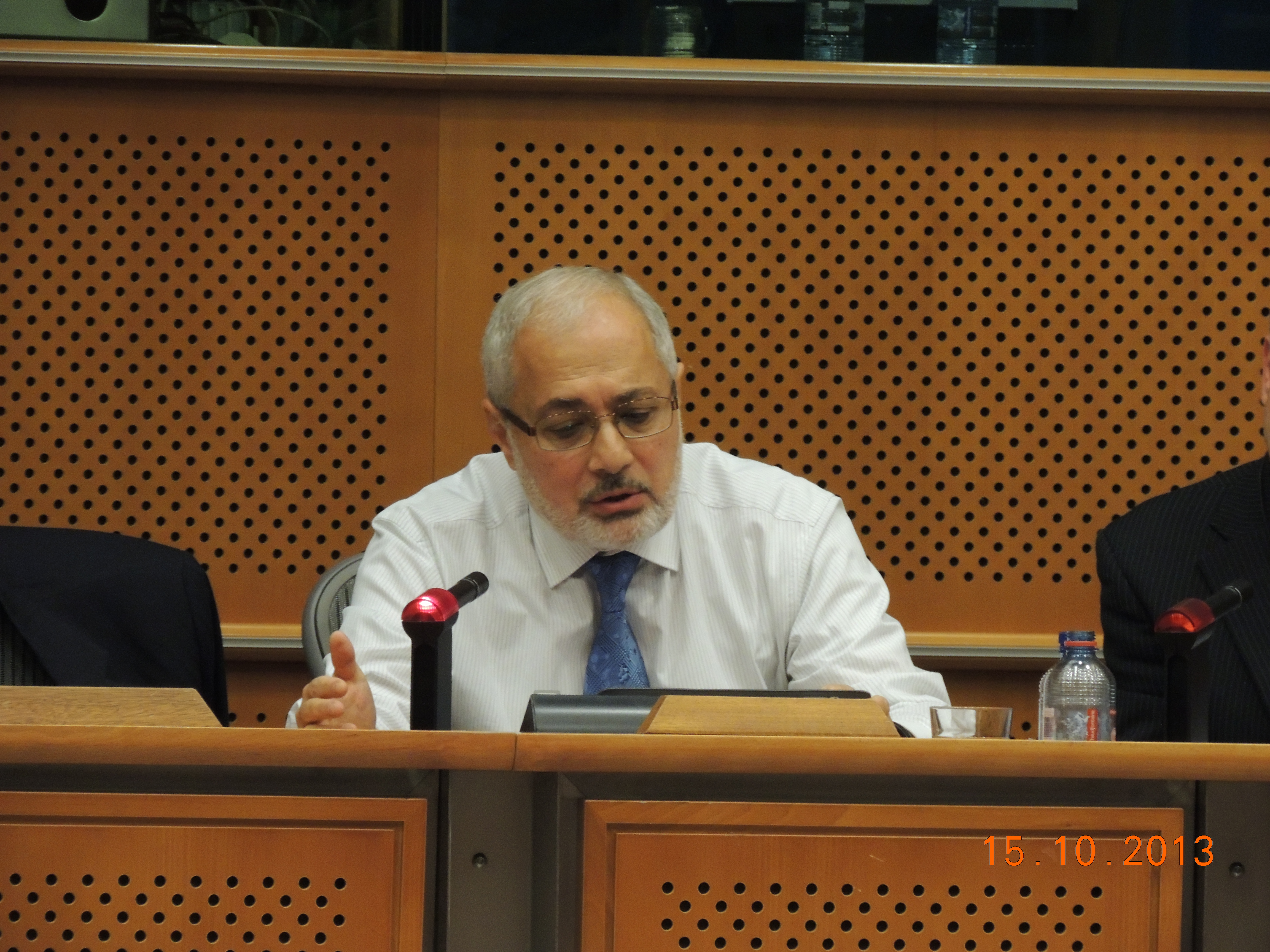 That was the year when the Armenian nation, almost completely destroyed by the Genocide and war, found strength and will to restore its homeland from ruins and ashes and create an independent state. But that independence did not last long. In 1920 the first Republic of Armenia fell to the double aggression from Kemalist Turkey and Bolshevik Russia. They occupied and divided Armenia – in the same way as two decades later Stalinist Russia and Nazi Germany occupied and divided Poland and the Baltic States.
That was the year when the Armenian nation, almost completely destroyed by the Genocide and war, found strength and will to restore its homeland from ruins and ashes and create an independent state. But that independence did not last long. In 1920 the first Republic of Armenia fell to the double aggression from Kemalist Turkey and Bolshevik Russia. They occupied and divided Armenia – in the same way as two decades later Stalinist Russia and Nazi Germany occupied and divided Poland and the Baltic States.
Part of Armenia was occupied by Turkey and devoid of its Armenian population; another part was captured by the Bolsheviks. Armenia resisted fiercely, never being an obedient subject; the first and successful rebellion against the Bolshevik rule in 1921 made Armenia independent for a short time, but enemy forces were overwhelming and independence was lost. Afterwards, came the cruel punishment – what was remaining of Armenia was dismembered again: Nakhichevan region, as well as Karabakh, forcibly against the will of their Armenian population, were passed to Azerbaijan, which joined Soviets voluntarily.
The totalitarian regime used different means to keep national republics in submission. One of them we conditionally call “the Caucasian model”; the main feature of it was the intentional deformation and distortion of the ethnic or administrative borders. They were carved in such way that no republic or ethnic entity could break away without a conflict with the neighbours. This was not the only model. There was also the so-called “Baltic model”, when the ethnic composition of the republics became the main target. The conflicts in the Southern Caucasus particularly emerged as a result of artificially drawn borders.
Forcibly included in the administrative structure of Azerbaijan, Karabakh, where 95% of the population was Armenian, was subject to various forms of ethnic and religious discrimination, and economic deprivation. Intentional demographic manipulation resulted in widespread ethnic cleanings.
The long decades of Soviet and Azerbaijani rule did not eliminate the desire of Armenians for freedom and independence – neither in Armenia, nor in Karabakh.
The current stage of the struggle for liberation of Mountainous Karabakh began in 1988, when the inhabitants of that historical Armenian province, encouraged (or deceived) by perestroika and glasnost, began to take peaceful steps to break free from Azerbaijani control. Soviet Azerbaijani authorities answered with brutal acts of violence and pogroms, directed against the defenseless Armenian civilians. On February 26, 1988 the international community witnessed the massacre of Armenians in Sumgait, one of the largest cities and industrial centers of Azerbaijan. In Karabakh, series of attacks on Armenian villages were launched. They were committed with full support of the Soviet authorities and military. For example from January to May 1991 the inhabitants of 24 Armenian villages in Karabakh were forcibly driven from their homes. Many were killed or burnt alive like in Sumgait. The sudden outbreak of the Azerbaijani violence revealed the real roots and causes of the conflict and made them so clear and obvious that the European Parliament voted for a resolution, which in particular included the following expressions:
“Having regard
– to the historic status of the autonomous region of Nagorno-Karabakh as part of Armenia,
– to the arbitrary inclusion of this area within Azerbaijan in 1923 and
– to the massacre of Armenians in the Azerbaijani town of Sumgait in February 1988,
whereas the deteriorating political situation, which has led to anti-Armenian pogroms in Sumgait and serious acts of violence in Baku, is in itself a threat to the safety of the Armenians living in Azerbaijan,
The European Parliament condemns the violence employed against Armenian demonstrators in Azerbaijan, and supports the demand of the Armenian minority for reunification with the Socialist Republic of Armenia.”
As a result of severe persecutions, Armenians and the people of Mountainous Karabakh were left with only three choices: leave their ancestral homeland, submit and die, or fight for their freedom and survival. Karabakhi Armenians preferred the third option. In full accordance with the existing law they announced their independence from Azerbaijan, created their own statehood, establishing the Government and electing the Parliament of the Mountainous Karabakh Republic. Azerbaijan responded with aggression and full scale war, attacking Armenian villages and bombing and shelling towns and the capital city – Stepanakert. Then Armenians of Karabakh created an army and organized total defense of their tiny country.
And they won. Nobody could expected that, but they did. They were merely 150.000 thousand people against 7.000.000 strong Azerbaijan, and they won. They liberated all the territories under Azerbaijani occupation and took under their control several strategically important positions around their Land, creating a security belt. After series of military failures in May 1994 Azerbaijan was compelled to ask for peace and signed a cease-fire agreement with MKR.
Years later the Azerbaijani nationalist propaganda invented an explanation for their defeat in the war unleashed by that country against the Mountainous Karabakh Republic, blaming Russia for some imaginary support of the Armenian side.
Documents from different sources clearly show which side of the conflict launched by Azerbaijani intolerance benefited from Russian arms and armament supply more. For instance, having already more than double superiority in arms left by the Soviets, Azerbaijan between 1992-1994, during the most active phase of the military confrontation, received from Russia approximately 1,5 times more tanks, 3 times more armored combat vehicles, 2 times more artillery systems and grenade launchers than the Armenian side. Against dozens of military airplanes transferred to Azerbaijan, Armenia received no air force at all.
Twenty years have passed since the day the cease-fire was signed. The peace talks coordinated by the Minsk Group Co-Chairs have still not achieved any tangible results because of the unrelenting and aggressive stubbornness of Azerbaijani leadership.
Unfortunately the international community had never paid enough attention to the fact that Azerbaijan used all passed years not for reaching full peace agreement but rather for militarizing its society and preparing it for a revanchist war. Hate speeches, militarist statements, threats and bold hostility of the Azerbaijani authorities aimed at Armenia and Mountainous Karabakh, and Armenians all over the world, as well as arms race propelled by Azerbaijan must be considered as a serious threat of war. Azerbaijan and its closest ally Turkey continue their blockade of the MKR and Armenia, which began more than 20 years ago, trying to exert pressure on Armenians in the peaceful settlement process.
But I am not going to relate in details the dark days of war, losses, destruction or the following years of the futile negotiations.
I will only try by giving you one or two examples to demonstrate what kind of traps Azerbaijani propaganda set on the road to the peaceful solution, using not only Turkey’s diplomatic ties and potential, but also the so-called “caviar diplomacy” based on the oil money.
First of all, I would like to stress that any direct comparisons of the Karabakh conflict with seemingly similar situations in the world lack the necessary understanding of its essence. While for Baku a victory is a matter of pride and ambition, for Armenians in MK it is a matter of life and death.
From this point of view, any attempt to describe the conflict as a confrontation of two principles of international law – the right of self-determination from one side and the territorial integrity from the other – is artificial and aimed at hoarding the inextricable obstacles for the peaceful solution. This artificial confrontation and the dispute over the priority of one of them is the basic method of the Azerbaijani propaganda. And this is complete nonsense.
The international legal system is not a hierarchy of principles. There are no first and second rate international laws. They are simply meant to be implemented in different areas. The principle of territorial integrity refers to relations between sovereign states and is one of the instruments against the policy of occupation and annexation. But when within a state an ethnic minority living on its historical land is severely oppressed, deprived of human rights, its historical and cultural heritage, prospectives of development, and forced to leave the land of its ancestors, then for such ethnic minorities the provision of the international law is clear: the right of self-determination can and must be implemented. So the establishment of the Republic of Mountanious Karabakh on the basis of the right of self-determination should not be considered in the scope of the territorial integrity of Azerbaijan.
Another trick of the Azerbaijani propaganda is more complicated. During all stages of peace talks Azerbaijani authorities stubbornly insist on dealing only with the consequences of the conflict, refusing to address to its causes. That’s understandable; the consequences are visible, obvious, even striking: human losses, disabled people, refuges, destroyed villages, towns, roads, bridges, neglected fields and factories. But healing those wounds would be impossible without dealing with the causes which led to the bloody conflict. And that is not an easy task because the true causes are often hidden, and hidden with a purpose. Apparently, by that Azerbaijan tries to avoid the responsibility for launching and escalating the military aggression against its neighbor – Karabakh, which gained independence and sovereignty on the same legal basis as Azerbaijan, Armenia or other republics of the former Soviet Union.
I am absolutely sure that only the complex approach to the conflict and ways of its resolution without artificially separating the causes from the consequences of it can bring the historical reconciliation of the whole region. That will be impossible if one of the sides of the conflict namely Azerbaijan is continuing its policy of seeking “the ultimate victory” without any concession from its side.
The infamous history with the axe-murderer Ramil Safarov, who killed his sleeping colleague-officer during the NATO training courses in Budapest only because that officer was Armenian, and later was declared and praised as a national hero in Azerbaijan, shows that in that country Armenians can never feel safe, can never have a future. How else can Armenians in Karabakh interpret the constant refusal of the Azerbaijani authorities to withdraw snipers from the contact line between the armies; the persecution of the Azerbaijani writer who had courage to express his sympathy to the victims of anti-Armenian pogroms; constant refusal of Azerbaijani authorities to discuss the situation with Karabakh directly?
The conclusion is simple – a peaceful solution of the conflict and subordination of Karabakh to Azerbaijan are incompatible.
Due to the fact that the MKR has not yet been recognized by the international community, in different instances Armenia represents and defends its interests, but cannot completely replace it. MK is a main and independent party to the conflict. Thus only the full inclusion of it in the ongoing negotiation process can give real opportunities to make them effective and resulting in the settlement of the conflict.
MKR encompasses all the attributes required by international law for the creation of an independent state and necessary for international recognition. That, specifically, requires:
– a permanent population
– a defined territory
– a permanent administration organized under common political institutions exercising exclusive jurisdiction on the defined territory and people
– and capacity to enter into relations with other states.
As you can see MKR meets the criteria set by the Montevideo Convention for international recognition of statehood.
But there is one specific, very distinctive feature that makes Karabakh deserving the recognition and peaceful life: it is a democratic country. Unlike the Azerbaijani nouveau-riche elite, where the victory in presidential elections with 85% of votes is declared even before the elections are finished, the Artsakh authorities have never used the pretext of the conflict as an obstacle to democratic reforms.
The gates are open. Welcome to Karabakh, it is not a difficult travel, and you will see firsthand the evidence that Karabakh is far ahead of Azerbaijan in the issue of human rights and civil liberties.
The inevitable international recognition of that republic should not be viewed as an act of hostility towards Azerbaijan. In the long run it will serve common interests. Azerbaijan and Karabakh can soon begin to put their tragic past behind and move toward a brighter future together.
Two words about Armenia.
Here in the European Parliament, I would like to mention that the frustration with the latest political developments in Armenia from the side of our colleagues – Members of the European Parliament, is obvious and maybe even partly understandable. Of course, we would like our colleagues to remember the day in 2008 when the highest representatives of the EU, and the USA expressed in their welcome speeches the strong wish for Turkey to lift the blockade of Armenian borders. The blockade is still in place, choking my country.
And when I see the latest amendments to the EU report and resolution on Azerbaijan and Armenia tabled by some of our distinguished European colleagues, I realize that the lack of understanding of the situation around Mountainous Karabakh conflict continues to produce more and more dangerous mistakes.
Take only one example – the proposal to make the future approximation of both countries to Europe dependent on the progress in the MK conflict resolution. Sounds good. But it is a trap which can create an impenetrable obstacle to the conflict resolution. The problem is that unlike Armenia, Azerbaijan is absolutely not interested in such approximation. So can this approach be considered as a kind of punishment. But for what? For our attempt to deal with the reality?
I noticed that in the last years the fiercest attacks of Azerbaijani forces against the Armenian troops and civil population were happening not spontaneously. There has been a grim logic un them. If you try to draw a correlation graph it will immediately become evident that those violations of the cease-fire established almost 20 years ago have coincided with the most important key meetings during the long process of the EU-Armenia negotiations. One does not need a wild imagination to realize that behind that coincidences a cunningly considered policy lies: precisely – to scare off, to deter the government and the society of Armenia from the idea of the approximation and integration with Europe. I would not speculate on the matter of how and from where such attacks could be inspired and whose interests they apparently served.
Anybody can compare the dates of the main meetings and events of the negotiation process with the dates of the sniper or diversionist assaults of the Azerbaijani troops on the Armenian civilians and positions on the borderline. I am not going to overburden your attention with the dates or events. I will simply publish them very soon.
In spite of all the difficulties whether they were predictable or emerged unexpectedly, I am absolutely confident that the European integration has no alternative for Armenia. Today we are compelled to take into account that some of the vital aspects of our existence: military security, energy security and economy prevail over our inspirations. But that will not last forever. In process of time the political and ideological vectors will straighten our course.
The proposal “that the conclusion of the EU association agreement with Armenia and Azerbaijan be linked to the progress towards the resolution of the Nagorno-Karabakh conflict” creates a serious problem. It puts Armenia in the position of a hostage. Azerbaijani autorities are absolutely not interested in the peaceful solution based on the principles of self determination of the peoples, territorial integrity and non-use of force. They reject any mutual concessions and openly prepare their country for war. More than that: they do not even consider the association agreement with the EU as a political goal of their country, being sure that the “caviar diplomacy” is self sufficient. All they do is to use the pretext of the “unresolved conflict” to avoid any real reform aimed on the democratization of Azerbaijan.
Thus, linking the future association agreement with the resolution of the MK conflict is exactly what Azerbaijani authorities want, as it will create new obstacle for Armenia’s ability to maneuver independently. I hope my point of view will be taken into consideration.
Thank you for your kind attention.


